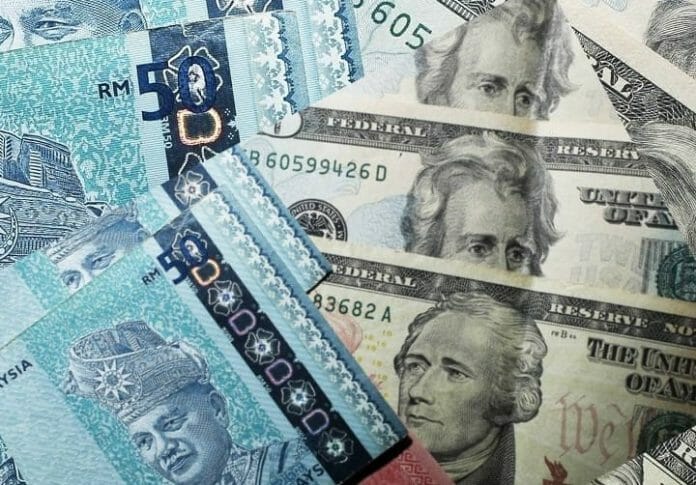The ringgit ended lower against the US dollar on Friday due to a lack of market catalysts, exacerbated by global market uncertainties, dealers said.
At 6 pm, the local note depreciated by 35 basis points to 4.7460/7495 against the greenback from Thursday’s close of 4.7425/7460.
SPI Asset Management managing director Stephen Innes said the US dollar continued to strengthen after the US Federal Reserve (Fed) signalled the US central bank’s stance to continue increasing interest rates going forward.
“As we suggested yesterday, the overnight policy rate (OPR) hike by Bank Negara Malaysia (BNM) is only 25 basis points compared to the Fed’s hiking of 75 basis points, so from a strictly monetary policy perspective, the US dollar is still in the driver’s seat.
“In unambiguous contrast to the Fed, BNM threw in the towel on over-hawkishness weighing near-term inflation risks versus slowing activity and only raised 25 basis points for fear of driving a deep recession,” he told Bernama.
Innes said there is a significant element of political risk weighing on the ringgit ahead of the 15th General Election, which is keeping foreign investors side-lined, hence the demand for the local note remains muted.
Meanwhile, the ringgit was traded mostly lower against a basket of major currencies.
It weakened against the euro to 4.6383/6417 from 4.6258/6292 at Thursday’s close, depreciated against the Singapore dollar to 3.3517/3546 from 3.3353/3383 and decreased vis-a-vis the Japanese yen to 3.2111/2137 from 3.1992/2018 yesterday.
The local note, however, appreciated against the British pound to 5.3231/3270 from 5.3372/3411 previously.
Meanwhile, the dollar also tumbled on Friday after the U.S. nonfarm payrolls report for October showed the world’s largest economy created more new jobs than expected, but also flashed signs of a slowdown with a higher unemployment rate and lower wage inflation.
The greenback initially rose immediately after the data, but fell as market participants digested the jobs report, noting the data was not all positive and supports the view the Federal Reserve could slow the pace of future rate hikes.
U.S. nonfarm payrolls increased 261,000 last month, data showed on Friday. Data for September was revised higher to show 315,000 jobs added instead of 263,000 as previously reported. Economists polled by Reuters had forecast 200,000 jobs, with estimates ranging from 120,000 to 300,000, Reuters cited.
However, the unemployment rate rose to 3.7% from September’s 3.5%. Average hourly earnings increased 0.4% after rising 0.3% in September, but the rise in wages slowed to 4.7% year-on-year in October after advancing 5.0% in September.
The fed funds futures on Friday priced in a 52.5% chance of a 75-basis-point interest rate hike next month, and a 47.5% probability of a 50-basis-point increase. The odds of a 75-basis-point rise went as high as 64% immediately after the payrolls data.
The Fed’s terminal rate, or the level at which rates would peak, slipped to 5.09% late on Friday, from about 5.2% just before the data.
“Although today’s report is a pretty mixed bag overall, we do not see how the Fed can look at this data and think that they are making meaningful progress towards getting inflation under control,” said Thomas Simons, money market economist, at Jefferies in New York.
“Payroll growth is slowing and wage growth is decelerating, but neither one is slowing fast enough. Today’s data leaves the possibility of another 75-bp rate hike firmly on the table for the December FOMC meeting, though obviously we have several other important data releases between now and then.”
Despite the strong jobs data, Fed officials on Friday said a smaller rate increase is still on the table for the December policy meeting.
The jobs numbers show “the labour market remains tight,” Richmond Fed President Thomas Barkin told broadcaster CNBC soon after the release of the data, adding he nevertheless is ready to act more “deliberatively” on the pace of future rate increases even as he keeps an open mind on the outcome of the next policy meeting in December.
The dollar fell 1.1% against the yen to 146.65 yen, posting losses for a third straight week.
The euro, on the other hand, rose 2.2% to $0.9960.
The dollar index, a measure of the greenback’s value against six major currencies, fell 1.9% to 110.77, on track for its largest one-day percentage loss since November 2015.
Speculators reduced their net long bets on the U.S. dollar to $3.08 billion for the week ended Nov. 1, compared with a net long position of $10.21 billion last week, according to calculations by Reuters and U.S. Commodity Futures Trading Commission data released on Friday.
The U.S. currency firmed on Wednesday and Thursday after Fed Chair Jerome Powell on Wednesday said the central bank could continue to increase rates if inflation does not slow, causing markets to price in a higher peak for U.S. rates.









